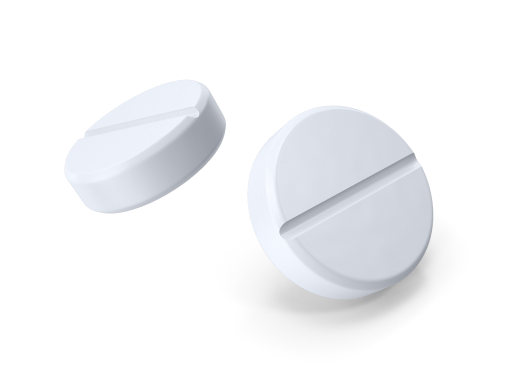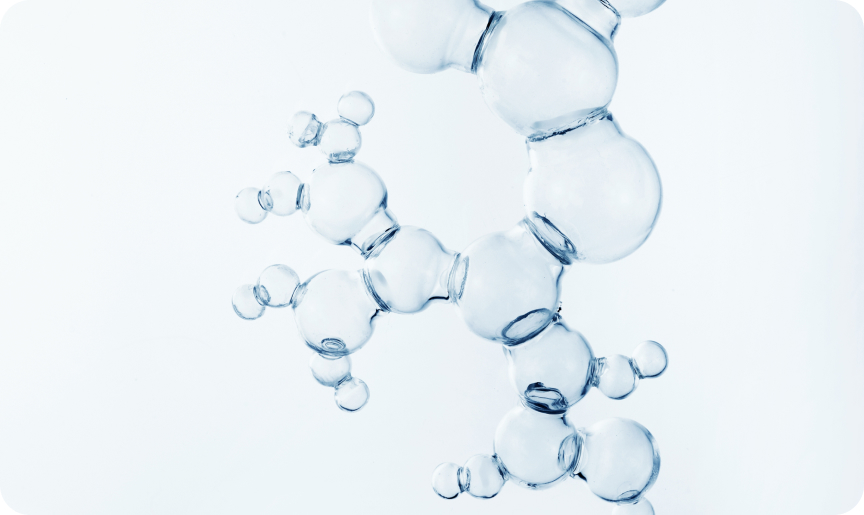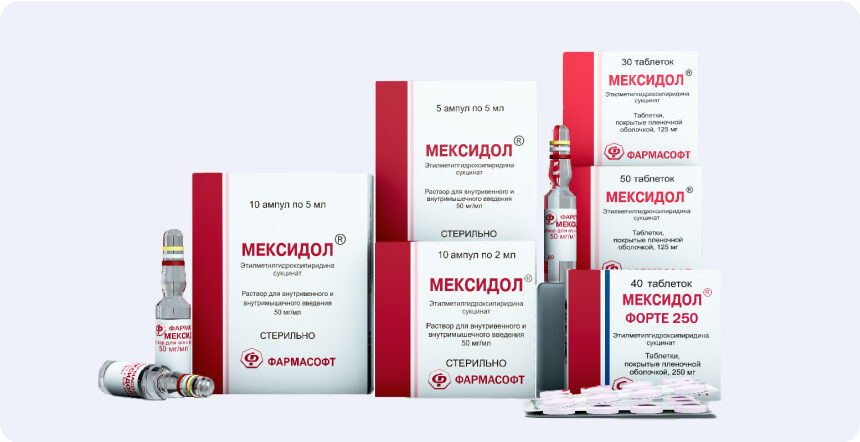Focus and hyperactivity deficiency syndrome (ADHD) is a disorder of the nervous system that affects the behavior, concentration and teaching of children. Children with ADHD are inattention, high distracting, excessive motor activity, impulsive behavior, and communication problems.
Mexidol: Use of the drug
in the treatment of attention deficit
hyperactivity disorder (ADHD)

What is attention deficiency and hyperactivity disorder (ADHD)?
How often and who has ADHD?
ADHD is diagnosed in approximately 5-15 % of children [1, 2]. In boys, the syndrome occurs approximately 3 times more often than in girls [3]. Adults suffer from syndrome less often. After 18 years, the frequency of occurrence fluctuates around 4–5 % [4]. Most often, the diagnosis is made when the child begins to go to school [5]. However, signs of ADHD are usually noticeable at preschool age.
Causes of ADHD
1. ADHD tend to be inherited. This fact is confirmed by more than 50 % of patients [6, 7]. Biochemical mechanisms associated with impaired function of neurotransmitter systems of the brain have genetic dependence. The imbalance of the exchange of catecholamines (norepinephrine, dopamine and serotonin) and their oxidation leads to the formation of free radicals [8–10]. Thus, oxidative stress develops, the products of which have a negative effect on brain cells. This is the cause of ADHD. Neuropsychological features are also important: the slowed formation of performing functions, the maturation of the prefrontal cortex.
2. Organic factors. The complex course of pregnancy and childbirth in the mother, chronic fetal hypoxia, prematureism, intrauterine infection and other factors can cause ADHD.
3. Socio-psychological factors. They are assigned an important, but not a key role in the formation of ADHD. Low social status or severe disagreements within the family, alcoholism in parents, unbalanced nutrition of the child, as well as environmental pollution by microelements of heavy metals, for example, lead, can cause behavioral disorders in children [7].
Modern classification distinguishes three types of ADHD:
- 1
Mostly an inattentive
20-30% of cases is more often detected
in adolescents; - 2
Mostly hyperactive/impulsive
15% of cases, more often determined
in preschool children; - 3
Mixed
50–75% (the most common form), there are all groups of symptoms [1.11].
Symptoms of ADHD
Most often, a mixed version of ADHG in children begins to manifest itself already at the age of 3-4 years. The child is easily excited, flirting, may show impatience (trying to get what he desired as soon as possible, interrupts others). Due to impulsive behavior, a child can injure himself or other people. Often, with this form of ADHD, children cannot recognize the defeat in the game and excessively emotionally or even aggressively react.
The emotional splash follows overwork, which is manifested by tearfulness and moodiness, against this background problems with falling asleep are possible. Parents most often characterize this condition as “overgrow”.
Children with ADHD constantly have difficulty in learning. First of all, restlessness, the inability to concentrate on the tasks and bring their solution to the end prevent the training. The child suffers from forgetfulness and distraction. For example, he can run for some purpose during the game, but be distracted by something along the way. The child's attention quickly switches. This especially interferes with the development of reading and account skills. Such classes quickly bother them, and their attention goes to other things.
Thus, the key symptoms of ADHD are inattention or attention deficit, hyperactivity and impulsiveness [5]. Inattention becomes noticeable when the child encounters tasks requiring a thorough study of the task, a quick reaction, perception of visual and verbal information, and concentration of attention. Impulsiveness is manifested in the form of hasty actions that can lead to undesirable results (for example, children who run around without looking back the carriageway). Hyperactivity is determined by excessive motor activity and creates problems with perseverance both during classes and during leisure hours, for example, when reading or watching films. ADHD does not affect the intellect of the child, but greatly complicates the educational process, interferes with being disciplined and fulfilling the requirements of the teacher.
Who is diagnosed
with ADHD?
The activity or moodiness of the child is not a sign of ADHD. Only doctors who focus on modern approaches to the diagnosis of this disease can make an accurate diagnosis [5].


Diagnosis of ADHD
There are special criteria to make a diagnosis. They take into account the patient's age, symptoms and its duration. Symptoms should be observed at least 6 months, have an early age of manifestations - up to 7 years, extend to all spheres of life. The diagnosis of ADHD, according to the criteria for the international classification of diseases of the 10th revision, can be established if at least 6 of the inattention symptoms listed below, 3 symptoms of hyperactivity and 1 symptom of impulsivity [5].

Symptoms of inattention:
- The child is not able to fix attention on the details, makes many mistakes.
- It is difficult for him to keep attention when performing school tasks
or during games. - He does not listen to speech addressed to him.
- Cannot follow the instructions and bring the matter to the end.
- He cannot plan and complete the tasks.
- Avoids the implementation of cases requiring long -term mental stress.
- Often loses his things.
- Easily distracted.
- Shows forgetfulness.

Symptoms of hyperactivity:
- The child has restless movements, he is constantly spinning and spinning.
- It cannot sit still when the rules require this.
- The child shows excessive and aimless motor activity in unacceptable situations.
- He cannot play quietly and calmly.
- Located in constant movement.
- It is distinguished by talkativeness.
Symptoms of impulsiveness:
- The child without hesitation answers questions.
- Can't wait for his turn.
- It interferes with others and intervenes in conversations and games.
ADHD forecast:
In most cases, ADHD has a favorable prognosis. In the process of growing up a child, neurotransmitter imbalance in the brain system is fully or partially compensated. This allows you to reduce the severity of many symptoms of syndrome by adolescence. However, the clinical picture of ADHD can also be observed in adults. An unfavorable prognosis of ADHD can have in the case of a combination of syndrome with other mental illness. The condition for the successful social adaptation of children with ADHD is the interaction of specialists of different profiles, schools and family [5].

How to treat ADHD?
Treatment of ADHD should be a complex of measures that take into account the individual characteristics of the child. The key cause of the disease, the links of pathogenesis, the clinical picture, the presence of comorbid diseases are taken into account. The most important goal of treatment is to eliminate or reduce the severity of the symptoms of the disease. This is necessary to improve the quality of life and adapt the child in society. The most effective method of treating ADHD today is the combination of drug and behavioral therapy with family psychotherapy and psychological and pedagogical correction [7, 12]. As a drug treatment in therapy for ADHD in the Russian Federation, atomoxetine, nootropic drugs of various groups (pyrrolidone derivatives, gamma-aminoxylic acid, neuropeptides, multicomponent drugs) are used.
With severe hyperactivity and related behaviors of behavior, antipsychotics can be prescribed [5, 13]. The use of drugs aimed at reducing oxidative stress and protecting brain cells from free radicals is promising [14].
Mexidol® is an original Russian antioxidant and antihypoxant of direct energy with a wide range of pharmacological effects. Mexidol® consists of two related and functionally significant compounds: 2-ethyl-6-methyl-3-hydroxypyridine and succinate, the combination of which causes its multimodal properties. Mexidol®, with attention deficiency syndrome, is antioxidant, antihypoxic, and membrane -stabilizing effects. Thanks to this combination, the drug has a wide spectrum of multimodal properties, such as nootropic, anti -amnestic, anti -alert and other clinical effects. Mexidol® has a high security profile and practically does not have side effects [15, 16]. Mexidol® is a modern neurometabolic drug that is widely used in pediatric practice [17]. The multicenter-centered double blind randomized placebo-controlled in three parallel groups clinical examination of the drug Mexidol® in the treatment of ADHD in children aged 6 to 12 years
showed the advantage of the drug over the placebo when assessing the main and most secondary effectiveness criteria and the greater effectiveness of the treatment regimen Mexidol® tablets covered with a film shell 25 mg 2 times a day before the scheme 125 mg once a day.
Reliable clinical efficiency was demonstrated by:
- The sum of the total score on the scales of SNAP-IV “Inattention”, “Hyperactivity/impulsivity”. Compared to the initial level, the indicator decreased by 29 %;
- the indicators on the SNAP-IV scales compared to the initial level: “Inattention”-26.3 %, “Hyperactivity/impulsivity”-33.3 %, 33.3 %in terms of Conance index;
- The average change in the general assessment of SDVG symptoms on the ADHD Rating Scale-IV scale. Compared to the initial level, the change was 30.4 %;
- Assessment on the scale of the general clinical impression of the severity of ADHG (The Clinical Global Impressions-DHD-SEVERITY CGI-DHD-S)-52.3 % of patients with ADHG went into a light group;
- The assessment of the general clinical impression (The Clinical Global Impressions Scale-IMPROVEMENT, CGI-I)-improvement or significant improvement was noted in 52.2 % of patients.
A high use safety profile and good tolerance of the drug Mexidol® were also demonstrated
Based on the results of a clinical study of the use of Mexidol® for attention deficit syndrome, it was found that against the background of the use of Mexidol®, after 6 weeks of therapy, a comparable nature of the safety profiles of the testing of the drug Mexidol® and the placebo drug studied were obtained.
An effective treatment scheme with Mexidol® for ADHD - 1 tablet 125 mg 2 times a day for 1.5 months [17, 18]. The cost of a 1.5-month course of Mexidol® when taking 1 tablet 125 mg 2 times a day is less than 900 rubles, according to https://apteka.ru .
Clinical experience in using Mexidol with ADHD:
- The results of a multicenter dual-blind randomized placebo-controlled clinical study on assessing the effectiveness and safety of the drug Mexidol in the treatment of attention deficit syndrome in children (mega) N. N. Journal of Neurology and Psychiatry, VOL. 122, no. 4.
- Zavadenko N. N., Suvorinova N. Yu., Zavadenko A. N. The possibilities of using Mexidol in neuropediatrics. Journal of neurology and psychiatry named after S. S. Korsakova. 2023; 123 (9 issue 2): 1–8.

How to take Mexidol® for ADHD?
Block of articles on this topic
List of literature
- Diagnostic and Statistical Manual of Mental Disorders, 5th Edition (DSM - V). American Psychiatric Association. - Washington. - 2013. - 947 p.
- Wolraich Ml, Hagan JF, Allan C, et al. AAP Subcommittee on Children and Adolescents with Atting-Deficit/Hyperaactive Disorder. Clinical Practice Guideline for the Diagnosis, EvalUation, and Treatment of Attend-Deficit/Hyperaactivity Disorder in Children and Adolescents. Pediatrics. 2019; 144 (4): E20192528.
- Zavadenko N.N. Syndrome of attention deficit and hyperactivity: modern principles of diagnosis and treatment // J. issues of modern pediatrics. - 2014. —T.13, No. 4. -S. 48-53
- Nureev I.T., Kirkin V.I., Glorokazova M.V. Syndrome of attention deficit and hyperactivity in adults, its diagnosis and influence on the success of students' educational activities (literature review) // Vyatka Medical Herald. 2012. No. 1.
- Federal State Budgetary Institution “Federal Medical Research Center for Psychiatry and Narcology named after V.P. Serbian "Ministry of Health of Russia. Hyperkinetic disorders (ADHD). Ed. Korin E.V., Kupriyanova T.A. 2015.
- Faraone SV, Perlis Rh, Doyle ae et al (2005). Molecular Genetics of Attenation-Deficit/Hyperaactivity Disorder // Biological Psychiatry-2005-No. 57.-P. 1313-1323.
- Gillberg Christopher. ADHD and Its Many Associated Problems. - Oxford University Press.– 2014. - 304 p.
- Alvarez-Ellano L, González-García N, Salazar-García M, Corona JC. Antioxidants as a Potential Target Against Inflammation and Oxidative Stress in Attention-Deficit/Hyperaactivity Disorder. Antioxidants. 2020; 9: 176.
- Corona JC. Role of Oxidate Stress and NeurinflamMation in Attendation-Deficit/Hyperaactivity Disorder. Antioxid Basel Switz. 2020; 9: E1039.
- Robberecht H, Verlaet Aaj, Breynaert a, et al. Copper and Selenium Status in Attendation-Deficit/Hyperaactivity Disorder (ADHD). Mol Basel Switz. 2020; 25: E4440.
- International Classification of Diseases (10th revision): Classification of mental and behavioral disorders: clinical descriptions and instructions for diagnosis: trans. on Russian. ulcer. / Ed. Yu.L.
- Fabiano Ga, Pelham We, Coles ek et al. A META-ANALYSIS OF Behavioral Treattions for Attendation-Deficit/Hyperactivity Disorder // Clinical Psychology Review. -2009.-No. 29.-P. 129-140.
- Zavadenko N.N. Hyperactivity and attention deficit in childhood. M.: Yuraite; 2019. Zavadenko NN. Hyperaactivity and Deficiency of Attenation At Children's Age. M.: Jurite; 2019. (In Russian).
- Curpan as, Luca AC, Ciobica A. Potential Novel Therapies for Neurodevelopmental Disesses Targeting Oxidation Stress. Oxid Med Cell Longev. 2021; 2021: 6640206.
- Fedin A.I., Zakharov V.V., Tanashyan M.M. et al. The results of an international multicenter randomized double-blind-controlled study of the assessment of the effectiveness of the effectiveness and safety of sequential therapy of patients with chronic brain ischemia with Mexidol and Mexidol Forte 250 (study of Memo). Journal of neurology and psychiatry named after S.S. Korsakova. 2021; 121 (11): 7-16
- Schulkin A.V. Modern ideas about the antihypoxic and antioxidant effects of Mexidol. Journal of neurology and psychiatry named after S.S. Korsakova. 2018; 118 (12, issue 2): 87–93.
- Zavadenko N.N., Suvorinova N.Yu., Zavadenko A.N. The possibilities of using Mexidol in neuropediatrics. Journal of neurology and psychiatry named after S.S. Korsakova. 2023; 123 (9 issue 2): 1–8.
- Zavadenko N.N., Suvorinova N.Yu., Batysheva T.T., Bykova O.V., Platonova A.N., Gainetdinova D.D., Levitina E.V., cars V.V., Vakula and Vakula and Vakula and .N., Maksimova N.E. The results of a multicenter dual blind randomized placebo-controlled clinical study on the assessment of the effectiveness and safety of the drug Mexidol in the treatment of attention deficit syndrome in children (mega). Journal of neurology and psychiatry named after S.S. Korsakova. 2022; 122 (4): 75–86.
THE INFORMATION IS INTENDED FOR HEALTHCARE AND PHARMACEUTICAL PROFESSIONALS. THIS INFORMATION IS NOT INTENDED AS A SUBSTITUTE FOR MEDICAL ADVICE.
Source of photos and images Shutterstock.com